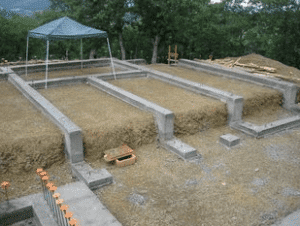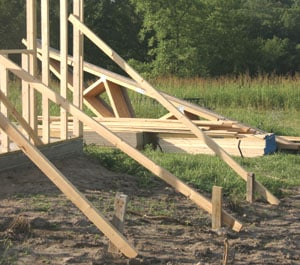Straw Bale Walls Over Framed Floors
Although many straw bale homes are built on a concrete slab, it’s not uncommon to build on raised floor foundations. Matts Myhrman has shared an excellent saying many times: “There is nothing you can’t do with straw bale construction except build thin walls.”
In other words, any foundation and flooring system will work for straw bale construction. Some people are interested in a crawlspace foundation because they want to minimize the use of concrete. Others want to build over a full or half basement to house their utility rooms and/or create root and wine cellars. Whatever the reason, some differences must be addressed when adding bales to a floor system rather than a concrete slab.

Footings
The footings necessary for a straw bale house may be slightly larger than on a conventional structure due to the weight of the bales and plaster on the floor system. Interior footings, i.e., footings inside the span of the floor system, will likely be necessary to carry the load of the overall floor system. Once the footers are poured, and in place, you can build your stem walls which can be poured concrete or masonry block, depending on the finished look you are aiming for. Interior pony walls and/or girder beams would also be installed at this time to support the floor joists.


With the stem walls in place, add your floor system to the top of the wall as with any floor system. Be sure to account for the increased “dead load,” the weight of the construction materials themselves, because the bale walls are much heavier than conventional walls and will affect the calculation of your floor joist size and spacing as well as how many interior beams or girders will be required to split the load across the span of the house.
You may want to consult with an experienced engineer when making the calculations. We typically factor 40 pounds per square inch for the bales’ dead load; however, your engineer will have to determine this number on their own so that they are comfortable with it.
When making calculations like this, most building inspectors want to see your actual calculations and ensure they are based on data, not assumptions. There are several ways you can account for the increased dead loads (click the arrows below to expand details):
Add additional girder support under the joists to cut down the floor spans.
Double the frequency of the joist layout from 24″ on center to 12″ on center.
Increase the joist depth from 12″ to 24″.
Change to a floor truss system in lieu of a floor joist system. This also makes running utilities a bit easier as the floor trusses have openings that allow for easy installation of wires, pipes, and ductwork.
Build a secondary bearing wall directly below the interior face of the bale walls to transfer that load off of the floor joists and down to the foundation.
As mentioned earlier in the E-course, the addition of the extra bearing wall creates a great place for running utility lines in a basement or even a crawl space (although the extra head room in a basement makes it more advantageous). Recognize that photo?

Keep in mind that if an interior bearing wall is used, it will have to be placed on a structural footing, so more concrete may be required. Although we like the advantage that the utility causeway creates, we prefer to utilize the first four options, more times than not, instead of adding more concrete to the project.
Slab vs Framed Floor
No matter what reasons inspire you to build over a framed floor, you can build that system with confidence. We find it much easier to build over a framed floor than over a slab. The biggest reason for this is that a slab is usually going to be used as the finish floor, which means it must be protected throughout the construction process. No small feat! Protecting the finished floor can be difficult and time-consuming, but the advantages may balance out for your build.
Secondly, a framed floor makes bracing exterior walls easier because nailers can be attached anywhere on the interior floor system, whereas a house built on a slab must be braced to the exterior. The biggest downside to building over a framed floor is that all of the thermal mass properties of a slab floor are lost.
As with any choice in construction, there are always pros and cons, and it is nice to know that there are several choices out there when it comes to foundations.

